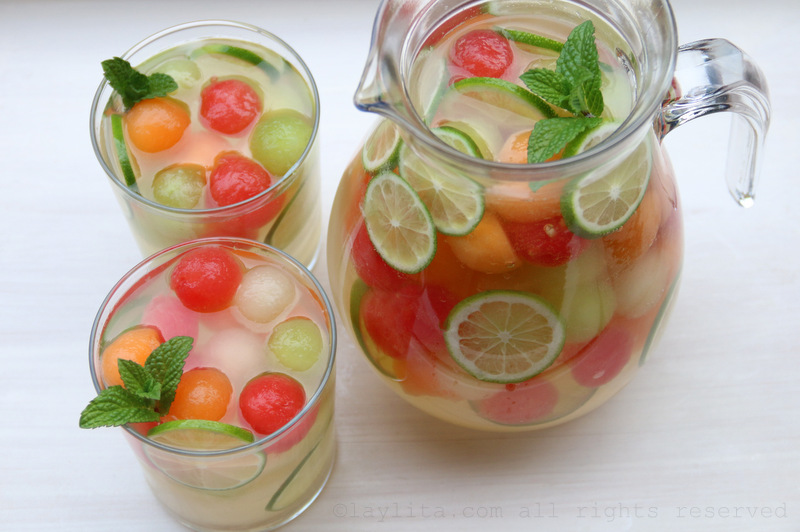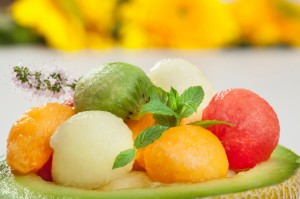There’s nothing bad about melons. They’re yummy; they’re super good for you, and they’re one of the most social foods around. No self-respecting summer picnic would be complete without a big ol’ watermelon! In fact, Americans purchase 3 billion pounds of the big green yum-balls annually. You’ll always find those big slices of sweet pink vitamin C-packed goodness, secretly supplying hungry partygoers with an abundance of vitamins, minerals and carotenoids.
One of my little treasured memories from when I was a little girl growing up in Ohio was of my dad and I munching away on a simply but delicious combination of Italian bread and watermelon. Yummy!
OK…Let’s learn a little bit more about melons.
Melonology 101
You can buy melons in the grocery store year-round, but they’re in season in America in the summer, so save your consumption for that season, and make sure you buy local. There are a couple of reasons to do this. First, once a piece of fruit is picked, it starts to lose nutrients, so not only do melons shipped from Central America tend to be mealier in texture, they’re also less nutritious. Second, imported melons are more expensive.
You can store a melon at room temperature for a few days. Refrigerating it will help the nutrients last longer, but you lose flavor, particularly with cantaloupes. Once you’ve cut it open, all bets are off. Seal that melon and store it in the fridge. It should last about a week.
And even though you’re probably not going to eat the rind, give your melon a good washing before cutting it up, so you can avoid any dirt, residues or pesticides (if it’s not organic) that might get into the flesh when you cut it.
While the watermelon is arguably the rock star of the melon world, having recently been rated the second healthiest fruit around by the Center for Science in the Public Interest (behind guava), it’s just one of dozens of melon varieties. Let’s discuss a few.
Watermelon
Actually, the watermelon is the only melon that’s not a member of the cucumis genus. It’s a member of the genus citrullus, which totally matters, right? Anyway, why did the CSPI go nuts for watermelons? They’re loaded with vitamins and minerals, including vitamins C, A, B6 and B1, as well as potassium and magnesium. More importantly, they’re loaded with carotenoids, pigments existing in plants that give them their vibrant colors. Carotenoids also have beneficial effects on those who eat them, including protecting cell walls from free radicals, improving your immune system and helping to maintain reproductive health.
One of the most prominent carotenoids in watermelon is cardiovascular-system-enhancing lycopene, which is usually associated with tomatoes, even though watermelon contains a much higher concentration by volume.
Although watermelon lacks fiber, it is incredibly water- and nutrient-dense, meaning you get a lot of vitamins and minerals for very few calories. One cup, which works out to about a pound of fruit, is only 49 calories. Furthermore, I defy you to show me anyone who’s ever gotten fat from eating watermelon.
Picking a good watermelon is easy. As is the case with all melons, once it’s been plucked from the vine, it stops ripening. So, don’t buy it hoping it’ll improve! According to The World’s Healthiest Foods by George Mateljan, there are two tricks to identifying a ripe watermelon. First, the “ground spot,” where it rested in the dirt, should be yellow. If it’s green or white, it’s probably not ready. Seedless watermelons sometimes don’t have ground spots, so this doesn’t apply to them. Second, give it a thump. If it responds with a dull thud, that’s good. It if sounds hollow, put it back.
On a final note, if you’re concerned about the genetic modification factor when it comes to seedless watermelon varieties, don’t be. They’re hybrids, meaning they’re a cross between two types of melon. No genes are manipulated in the making of this summer treat.
Cantaloupe
Let’s talk about the fruit the CSPI ranked as the eighth healthiest fruit. The cantaloupe, as we know it, is actually a muskmelon. Real cantaloupes are grown in France and rarely make it to the states. Muskmelons (or cantaloupes) are packed with vitamins C, A, B3, B6 and B9, as well as potassium. Unlike watermelons, they have a little fiber, a little over 1 gram for a 56-calorie, 1-cup serving.
They’re also a good source of carotenoids, particularly beta-carotene, which you’ll also find in carrots. Remember how I said carotenoids are pigments? Cantaloupes and carrots are both orange. Watermelons and tomatoes, with their lycopene, are both red.
Cantaloupes stop ripening when picked, but unlike watermelons, the tap test should sound hollow. They should have a subtle, fruity smell. If a cantaloupe smells too strong, it’s probably overripe. Also, the side opposite the stem should be slightly soft. Other than that, there should be no bruises or odd spots.
Another fond memory that I cherish from childhood was when mom used to cut a cantaloupe in half and fill it with vanilla ice cream. Oh what a treat! Matter of fact, I still love it!
Honeydew
Although they’re still yummy, honeydew melons fare poorly from a nutritional standpoint when compared to their pink and orange brethren. That 1 cup of cubes has 61 calories and 1 gram of fiber, but the vitamin C is only about half that of cantaloupe, and there are also much lower amounts of other micronutrients, although there’s still a pretty good amount of potassium.
The carotenoid that gives honeydew its green hue is zeaxanthin, which promotes eye health. You’ll find even more impressive amounts of zeaxanthin in almost all leafy greens.
You determine whether a honeydew’s ripe the same way you find a good cantaloupe. Hollow tap, fruity smell, and no soft spots.
Which melon is right for you?
All of them. What I love to do… is buy one of each! Chop them up, mix them together and have a colorful, nutrient-rich fruit salad that’ll be the hit of any party.
Mad About Melon Recipe
Ingredients:
- 3 cups watermelon (balls)
- 3 cups honeydew balls
- 2 cups cantaloupe balls
- 1/2 cup orange juice
- 1/2 cup lime juice
- 1/4 cup sugar
- 2 tbsps fresh mint (minced, or 2 teaspoons dried mint)
- 2 tsps grated orange peel
- 2 tsps grated lime peel
- 1 cup diet lemon lime soda
Mix all ingredients together and top with fresh mint. It is a fabulous summer treat!


Wow that was odd. I just wrote an extremely long comment but after I clicked submit my comment didn’t appear. Grrrr… well I’m not writing all that over again. Regardless, just wanted to say superb blog!